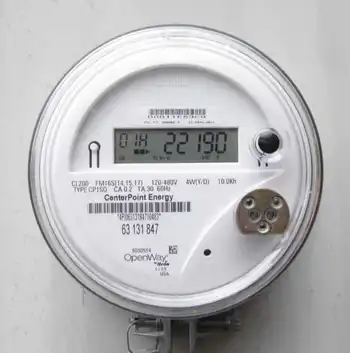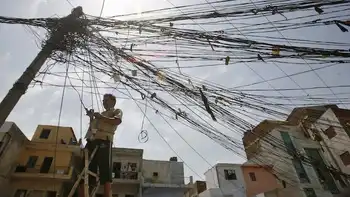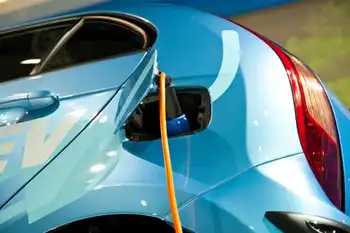Keeping home life-support up when power goes out
By Associated Press
Arc Flash Training - CSA Z462 Electrical Safety
Our customized live online or in‑person group training can be delivered to your staff at your location.

- Live Online
- 6 hours Instructor-led
- Group Training Available
It's an issue that snuck up on emergency officials as better medical treatments over the past decade have helped more critically ill people not only survive but move out of nursing homes.
The Associated Press found emergency planners around the country struggling to find new ways to identify people at risk before the lights go out, to ensure they will have the aid they need to survive small outages or big ones.
How serious is the problem?
When ice downed electric lines in Epping, N.H., last month, police found 60-year-old Richard Lapoint dead, hooked to his powerless oxygen machine. The town's rescue workers hadn't known he was power-dependent.
A generator and stack of batteries couldn't keep up with Gatlan Graham's ventilator and other life-supporting equipment when Hurricane Ike knocked out power to his Houston home for 14 days in September. The family fled in search of electricity, spending more than $1,500 to keep the 17-year-old alive.
When Hurricane Gustav hit Louisiana, dozens of people with home oxygen machines in tow evacuated to government medical shelters, where surprised officials had to scramble to find enough old-fashioned oxygen tanks when back-up generators in Baton Rouge failed.
Utilities in every state operate "medical priority lists" designed to track who depends on power for life. But an AP survey found huge state-to-state variations that suggest only a fraction of patients know they could sign up. Illinois' biggest utilities together report 10,000 patients on critical-care lists, for example. Neighboring Indiana's biggest list carries just 2,000 names.
Even if patients did sign up, in large outages companies don't have the ability to restore power to one home before another down the street. The lists may offer false hope.
"The power companies don't get on the phone and dial 911 for their customers," said Dr. David Prezant, chief medical officer for the New York City Fire Department, who is pushing for medical registries of the power-dependent. "When there's a blackout, citywide, nationwide, we are really unprepared with any structured database, knowledge of who these people are and where they are."
Registries are starting to form — from Benton County, Ark., to North Dakota, which begins a statewide Web-based registry this month.
A pilot project in northwest Ohio is giving cards to life-support users to hang in their windows during a flood or tornado, signaling to rescuers if they need help or are okay.
San Diego Gas & Electric says it recently met with each of its 700 known power-dependent customers to discuss emergency plans for outages, and offers advance warning when wildfires trigger rolling blackouts.
In contrast, this is the advice from Idaho's Public Utilities Commission: "If someone has a power requirement for life and health, the individual is responsible for coming up with their own back-up plans."
To help people prepare, the Food and Drug Administration this spring plans to issue the first checklist for device recipients to receive when leaving the hospital.
Emergency workers feel the clock ticking.
"It's incumbent upon us over the next 4 1/2 months, before we get into hurricane season again, to have a better plan than we had going into Ike," said Terry Moore, Houston's deputy emergency management coordinator.
Under consideration are mobile "charging stations" that could rotate through Houston neighborhoods for patients to recharge depleted batteries, or perhaps evacuating the power-dependent.
"This is a huge vulnerability," added Dr. Lewis Rubinson of the University of Washington, who advises the government on disaster preparations and separately is preparing guidelines for emergency oxygen supplies. "This is something that patients should demand."
It's a growing population. Roughly 2 million people use home oxygen machines, mostly "concentrators" that make oxygen on the spot as long as electricity flows. Just a few years ago, oxygen-gas tanks that don't require home electricity were the norm.
At least another 10,000 people breathe with home ventilators, and thousands more have implanted heart pumps called VADs, or ventricular assist devices.
There even are a few remaining users of those body-encasing iron lungs infamous from the polio era; Moore counts 19 in Houston-area homes. Last May, a Tennessee woman who spent nearly 60 years in an iron lung after childhood polio died when the power went out and her family couldn't get an emergency generator working.
Millions more use other at-home equipment: dialysis machines, nebulizers, IV and nutrition pumps, CPAP breathing masks. But power failures bring the most immediate risk for users of ventilators, heart pumps and oxygen.
Ventilators and heart pumps have internal batteries that last 45 minutes to a few hours, time to put on longer-lasting batteries or get to help. Some portable oxygen concentrators can run on batteries for three hours or four hours or be plugged into a car adapter, but patients typically depend on oxygen suppliers to deliver old-fashioned tanks of the gas for emergency use.
No one knows how often a power outage means death for such patients. Typically, death certificates note just the underlying disease, said disabilities specialist Lex Frieden of the University of Texas at Houston, who tried to track down the power-dependent during Ike's prolonged outage to see who needed help.
Back-ups sometimes fail even in short outages.
Last summer, 15-year-old Fernando Vargas died when a Boston power outage silenced his ventilator early one morning.
When the power went out in Carpentersville, Ill., the implanted pump powering Jack Bostwick's heart stopped, too, a week after the 60-year-old's optimistic discharge from the hospital in May 2007. The device's internal emergency battery somehow had dislodged, apparently giving him no time to insert longer-lasting ones. His family asks why Bostwick, newly registered on the utility's critical-care list, wasn't warned about a planned outage for pole repair. The utility declined comment because of a pending lawsuit.
But long outages are the big threat because batteries don't last and oxygen tanks need repeated refills.
"I thought I was prepared," said Houston's Kristin Graham. Before Hurricane Ike, she readied a generator, gasoline and rechargeable batteries that could run son Gatlan's ventilator for six hours to nine hours on a charge, and his oxygen machine for another few hours.
But the outage lasted so long, Graham said: "We couldn't afford to buy the highest-powered generator on the market. You can't run that generator 24 hours. You run it a couple of hours, you let it rest a couple of hours. I could never get all the batteries recharged."
Graham signed up for her utility's priority list and Houston's 211 emergency service, but said no one checked if she needed aid. Ultimately she loaded Gatlan, his medical equipment and his 4- and 8-year-old siblings into the family van and checked into a hotel room, first in a less hard-hit Houston area and later in cheaper Austin, to get electricity.
"I don't know what people would do if they didn't have a way to get out on their own," she said. "No one cared this time if you were on a critical list. They couldn't. It was too broad."
The 2003 Northeast blackout, the nation's largest power failure, was a wake-up call for New York City's Prezant. In a study published in the journal Critical Care Medicine, Prezant tracked citywide 911 calls plus emergency room visits at his own large hospital, Montefiore Medical Center, during the nearly 29-hour blackout.
The falls and heart attacks doctors had expected didn't materialize. But paramedics and the ER had a surge in patients with at-home oxygen, ventilators and other respiratory equipment who needed help or feared they soon would. Moreover, frail patients often were admitted to the hospital because doctors couldn't be sure a power failure was the only problem, a huge expense fraught with the risk of medical errors, said Prezant, a lung specialist.
When it comes to oxygen, many home health-care companies "bend over backward" to race tanks to customers during power outages, noted Washington's Rubinson. In fact, after Hurricane Katrina, the American Association for Home Care asked the government to designate oxygen providers as "first responders" for easier movement in disaster zones.
Medicare requires home oxygen suppliers to have customized emergency back-up plans for customers.
But if roads are impassable or the disaster's too big, home oxygen may not be delivered.
Yet there are no overarching recommendations on how many back-up tanks patients should keep on hand. Nor is there agreement about home generators, which have their own risk — deadly carbon monoxide poisoning if operated wrong — and can't always adequately power energy-hogging medical equipment. The FDA isn't advising generators in its patient checklist due out this spring, and the disabled often can't afford one.
But the AP survey found utilities frequently advise generators, such as Wisconsin utility We Energies, which also doesn't keep a list of power-dependent customers.
"There's a danger to keep the list and give a false hope you might be able to turn that power on sooner," said company spokesman Brian Manthey. "We feel more comfortable telling people you need to have a back-up plan," including generators or batteries.
Whatever a family's back-up plan, Rubinson and Prezant stress that local emergency officials must know how many power-dependent patients they might have to rescue, and getting utilities and home-care companies to share customer lists is a good start.
That's happening in northern Arizona. In Coconino County, home of Flagstaff, the emergency office gets a regularly updated medical-priority list from the state's largest utility, and records GPS coordinates for those homes so they can be found fast.
"We probably don't have 100 percent of everyone. There are people who slip through those cracks," said emergency planner Sherrie Collins.
Federal patient-privacy rules limit sharing, cautioned Bill Desmarais, a co-owner of Home Care Specialists Inc. in Haverhill, Mass., which had about 800 oxygen-dependent customers using back-up tanks when last month's Northeast ice storm cut power.
He does a home-safety assessment for new customers and offers a tank in advance, to keep for emergencies. Such tanks can be over 4 feet tall, weigh 80 pounds, "they're green and they're ugly," Desmarais said. "A lot of people don't like it as ornaments in their living room.... You can't force them."
Even the federal government was surprised by the demand during Hurricane Gustav, when nearly 1,400 people were housed in special medical shelters in Louisiana and Texas, 20 percent to 40 percent of whom required powered medical equipment. When generators failed in Baton Rouge shelters, an oxygen supplier hired to refill patients' oxygen tanks couldn't keep up with the unanticipated need.
"We had some nervous wringing of hands as some of the oxygen tanks started going down to low levels," said Dr. Allen Dobbs, chief medical officer of the National Disaster Medical System — although enough eventually was found. "We have to have reliable contingency back-up plans for these folks."











